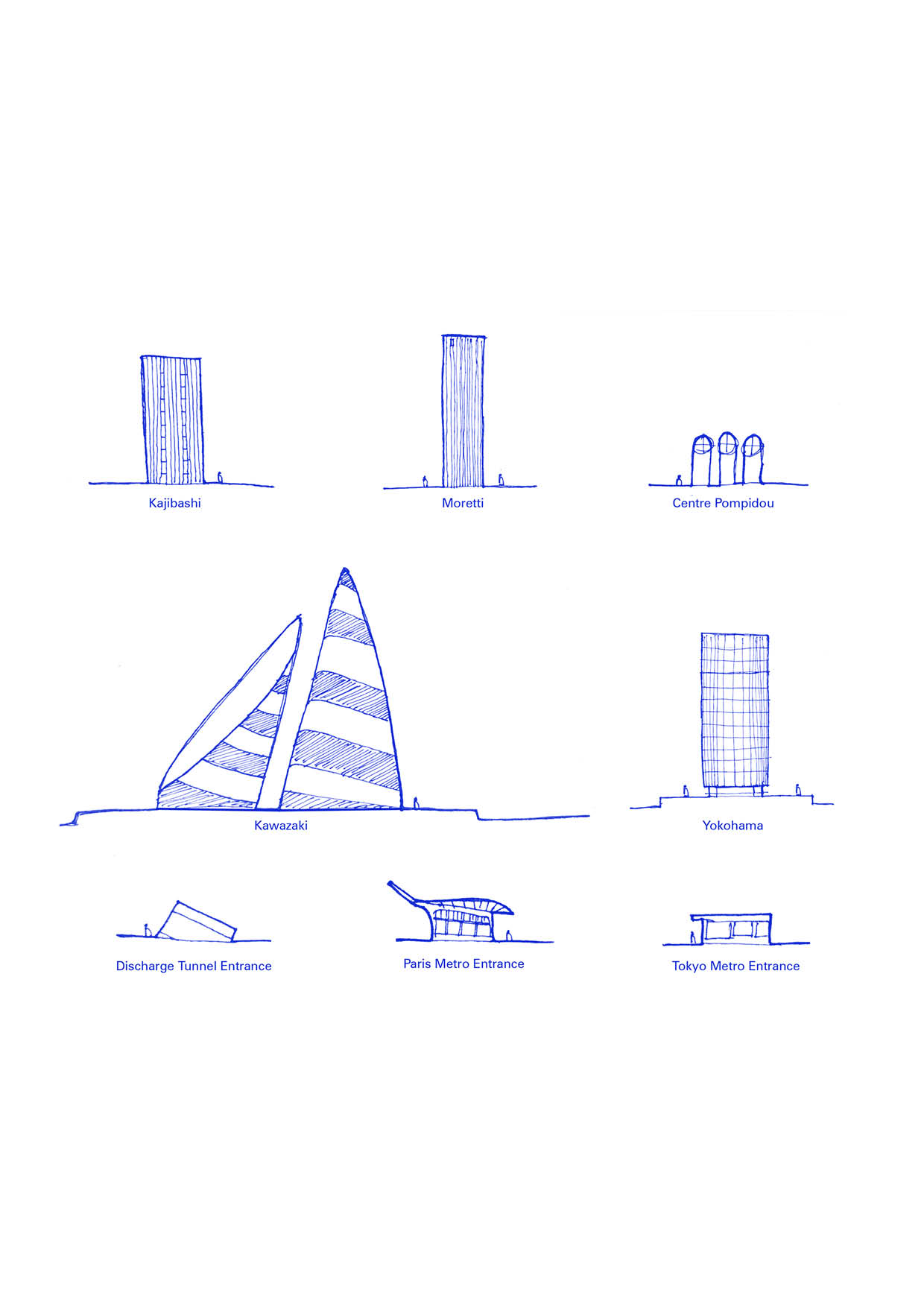
Periscope
Metropolitan, Underground, Object, Tokyo, Paris, Transportation, Infrastructure, Tokyo Bay, Illustration
Ventilation towers and metro stations entrances play a crucial role in the underground development as they are the technical solution to turn uninhabitable, dark and cold spaces to comfortable spaces. These objects work as entrance and exit of the hot-air fluctuating the urban spaces buried beneath the earth. Their function is to connect vertically the underground infrastructure with the city at ground level. For example, the Moretti ventilation tower in La Defense ventilates the entire underground highway system below the level of public plazas. Kaze no to is the tower of wind that allows the Aqualine to exist.1 This highway turns into a tunnel, needing constant circulation of air to regulate the temperature. The Toyo Ito wind tower in Yokohama is a great example of how engineering can work with architecture to achieve quality, design and function. The tower acts as a Metabolist object, ventilating by day and providing light at night. Metro stations entrances and exits have an important urban role in the public space. They link reality with fantasy, as entering Hector Guimard’s timeless sculptural metro stations feels like entering a portal to the underworld. Thanks to thermal buoyancy, the difference of temperature and pressure from the underground to above ground makes the hot air flow up and clean the air in the environment. The high percentage of the population commuting daily through the metro system, the electrical machinery needed for the metro infrastructure, and people circulating through the underground streets emit a high level of energy and heat, and here is when the ventilation system takes part and cools down the space.
1. Atlas Obscura, “Tower of Wind”, Tonny Dunnell, Accessed March 9, 2020
https://www.atlasobscura.com/places/tower-of-wind.
Metropolitan, Underground, Object, Tokyo, Paris, Transportation, Infrastructure, Tokyo Bay, Illustration
Ventilation towers and metro stations entrances play a crucial role in the underground development as they are the technical solution to turn uninhabitable, dark and cold spaces to comfortable spaces. These objects work as entrance and exit of the hot-air fluctuating the urban spaces buried beneath the earth. Their function is to connect vertically the underground infrastructure with the city at ground level. For example, the Moretti ventilation tower in La Defense ventilates the entire underground highway system below the level of public plazas. Kaze no to is the tower of wind that allows the Aqualine to exist.1 This highway turns into a tunnel, needing constant circulation of air to regulate the temperature. The Toyo Ito wind tower in Yokohama is a great example of how engineering can work with architecture to achieve quality, design and function. The tower acts as a Metabolist object, ventilating by day and providing light at night. Metro stations entrances and exits have an important urban role in the public space. They link reality with fantasy, as entering Hector Guimard’s timeless sculptural metro stations feels like entering a portal to the underworld. Thanks to thermal buoyancy, the difference of temperature and pressure from the underground to above ground makes the hot air flow up and clean the air in the environment. The high percentage of the population commuting daily through the metro system, the electrical machinery needed for the metro infrastructure, and people circulating through the underground streets emit a high level of energy and heat, and here is when the ventilation system takes part and cools down the space.
1. Atlas Obscura, “Tower of Wind”, Tonny Dunnell, Accessed March 9, 2020
https://www.atlasobscura.com/places/tower-of-wind.


